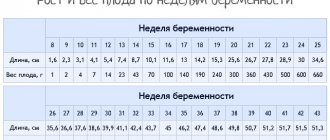In modern obstetrics, there is the concept of “full term” baby. This is a whole complex of physiological and anatomical factors that may indicate the full maturation of all organs in the fetal body. So, from what week is a baby considered full-term, and at what weight? Indeed, for a newborn baby, determining the degree of full term is important in the treatment and diagnosis of a number of diseases that develop immediately after birth. In any case, premature babies require special individual care, in particular feeding premature babies. In general, all this is aimed at maintaining all the basic functions of an immature child’s body.
Child at 3 months weight and height
The average weight gain for the third month is 700 grams, height 2.5 cm. Below is a table of the weight and height of a child at three months, based on WHO data.
Table of height and weight of a child at 3 months.
If your baby falls within the upper or lower limits, you should consult your pediatrician. Such indicators may be the norm. Only a doctor will give an adequate assessment of the child’s physical development. When assessing your baby's height and weight, you should not forget about the height and weight of mom and dad. After all, the child inherits the parents' genes. It is also necessary to take into account how much the baby weighed at birth.
Standards for height and weight of children WHO TABLES VIEW
Newborn weight gain and growth
First week - weight loss and first gains
The weight of newborn babies is very unstable in the first week and may decrease - this is a manifestation of a healthy norm.
In the first days of life, the young body intensively rids itself of excess fluid. For this reason, the baby can lose up to 7-10% of its original weight. For example, with an initial weight of 3500 g, a child can lose weight by almost 350 grams (up to 3150 g) in 3-4 days.
As a rule, such a drop in weight is clearly visible during natural breastfeeding, because the mother’s production of breast milk usually begins only 2-4 days after birth. Until then, the child eats only colostrum, which is produced by the mammary glands only in small quantities, which cannot have any effect on weight.
If the child is kept on artificial or mixed feeding, then the initial weight loss will be insignificant or will not appear at all.
Infant weight gain in the first week
| Gain, g | Average | Minimum |
| boy | 150 ±150 | -200 … -300 |
| girl | 100 ±100 | -150 … -250 |
* Gain is calculated from the initial weight with which the child was born
So, in the first week of life, boys gain an average of 150 grams, girls - 100 g. However, a significant percentage of children (about 25%) may show zero or negative gain (weight loss), and this is also normal for them. There will be enough time in the following weeks to compensate for the initial weight loss. But, in this case, the baby’s weight must be regularly monitored: after the first week, the weight must increase steadily, otherwise it is necessary to look for and solve a problem with feeding or health with the help of a doctor.
If on any day of the first week it turns out that the baby has lost more than 7% of its original weight, it is recommended to consult a specialist. If you have lost more than 10%, medical intervention is mandatory.
Gain and gain in the first month
The following table shows the approximate norms of weight gain and growth of infants in the first month of life (30-31 days).
So, it is advisable for a boy to gain 0.77–1.45 kg, for a girl 0.67–1.27 kg. Norms of newborn weight gain in the first month
| Weight gain, kg | Short | Average | Big |
| boy | 0,38 – 0,76 | 0,77 – 1,45 | 1,46 – 1,76 |
| girl | 0,40 – 0,66 | 0,67 – 1,27 | 1,28 – 1,58 |
* The table shows weight gain from birth to 30-31 days from birth
Low and high weight gain usually indicate that the feeding intensity can be increased or decreased accordingly. If the baby’s weight gain goes beyond the proposed ranges, then this is a reason for the local pediatrician to intervene. He must find the cause of too low or excessive weight gain (incorrect feeding, temporary illness of the child or mother, etc.). Then, depending on the child’s current growth and health indicators, the doctor develops feeding recommendations so that all indicators gradually return to normal.
Please note that many doctors, in the old-fashioned way, count weight gain from the minimum, they are more used to it this way. However, in modern weight gain standards, the count is based on the initial weight with which the child was born, since this makes it possible to evaluate gains more objectively. Therefore, the norms for weight gain in the first week and first month indicated on this website measure weight gain from the initial weight at birth.
Growth in the first month for boys is 3.5 - 6.0 cm, for girls 3 - 5.5 cm.
Baby's nutrition at 3 months
As in previous months of a child’s life, his menu includes exclusively breast milk or an adapted milk formula. No matter how much you would like to feed your baby porridge or something else, don’t risk it. The baby's digestive tract is not yet adapted to digest regular food.
READ more about the first complementary foods.
Breastfeeding
Newborn babies need breast milk. Therefore, a first-time mother, while still in the maternity hospital, must make every effort to stimulate milk production. It is painful, debilitating, but very important for the health of both this baby and subsequent children.
Accordingly, while the mother does not have milk, the baby should still be fed from the breast with colostrum, which is produced in small quantities by the mammary glands during this period. Colostrum is many times more nutritious than milk and contains many beneficial substances that provide the child with passive immune protection, activate the digestive system, and stimulate growth and development.
If the baby does not have enough colostrum, then until milk appears, he can be fed with an artificial formula, and only nipples with a minimum flow (minimum hole) should be used, otherwise the child may subsequently refuse the breast.
If the newborn is not put to the breast and is deprived of colostrum and breast milk, then the child is deprived of the enormous benefits received from natural feeding. Therefore, when feeding only artificial formulas, infants often experience weakened immunity, digestive problems (constipation, colic) become more acute, and a relatively weak psycho-emotional connection with the mother is formed. In addition, formula feeding is very expensive and constitutes a significant portion of the expenses for most Russian families.
How long does a 3 month old baby sleep?
A three-month-old baby sleeps from 14 to 17 hours a day. Daytime naps 3 to 5 times. Usually these are two long naps of 1.5-2 hours and two short naps of 30-40 minutes each.
At night, continuous sleep can last up to 6 hours. In total, the baby spends 10-12 hours on nighttime rest. If the child is in a good mood, he is active, not whiny and is gaining weight, then he sleeps enough.
To improve sleep, ventilate the room before your baby goes to bed, making sure that the room is not hot. An equally important indicator is indoor air humidity, this is especially true during the heating season.
How to humidify the air in a children's room
- Buy a special humidifier
- Place a damp cloth on the radiator
- Carry out wet cleaning
What should a baby's first aid kit look like? READ
Initial assessment of full-term newborn
To assess the full term of a newborn baby, there is a special Apgar scale. It involves assessing the intensity of the cry, skin color, muscle tone, the number of respiratory movements per minute, the presence of reflexes and heart rate. Up to two points are given for each parameter.
Moreover, neonatologists carry out the initial assessment in the first minute after the baby is born. On average, kids receive 7-8 points, since many of them are characterized by temporary cyanosis of the skin. After 5 minutes the assessment is repeated. Newborn children here already receive about 8-10 points, which is considered normal. If the indicator is within 4-7 points, the child’s condition is said to be of moderate severity. The baby’s extremely serious condition, which requires urgent emergency care, is characterized by a score of 1-3 points.
In addition, specialists can evaluate other external indicators inherent in full-term babies. Thus, their body length exceeds 45 cm, while the circumference of a child’s head is approximately a couple of centimeters larger than the circumference of the chest. There should be multiple grooves on the surface of the baby's sole. In this case, the lower and upper limbs themselves may be characterized by increased tone.
Among the main functional characteristics, it is necessary to highlight the ability to independently maintain normal body temperature, the absence of regurgitation after feeding, and pronounced physical activity.
What can a three month old baby do?
- At 3 months, the child confidently holds his head, and lying on his stomach, raises his shoulders and upper chest.
- Some children at this age can roll over from their back to their stomach.
- The baby enthusiastically examines the objects around him and tries to grab them with his hand.
- In response to the noise, the baby turns its head in the direction of the sound.
- The child actively walks, pronounces vowels and consonants. Babbling begins to form.
What to do with a three-month-old baby while awake
Train rolls from back to stomach and vice versa Put various bright toys in the baby's hands You can leave the baby on special developmental mats, with hanging toys Talk to the baby, sing songs, tell poems, nursery rhymes, fairy tales Show the baby different objects, describe them in words Do gymnastics, massage, air baths Walking with your baby in the fresh air
At what week is a baby considered full-term?
Traditionally, all criteria for a baby’s maturity are met at 40 weeks of pregnancy. However, when answering the question from what week is the baby considered full-term, experts call the 38th week of pregnancy. Once this important milestone has been passed, the fetus is considered sufficiently formed and completely ready for birth. Of course, there are also individual characteristics of the formation of a child’s body. However, after the 38th week of pregnancy, all organs and functions of the child’s body are considered developed.
On average, the weight of a fully formed baby at birth can fluctuate between 3300-3700 grams with a body length of 45-50 cm. It will not be possible to give an unambiguous answer to the question at what weight a baby is considered full-term. After all, this parameter is purely individual for each baby. In many ways, it will depend on the physiological characteristics and type of constitution of both parents, as well as the characteristics of heredity.
Under- or over-reading of a child’s height and weight
If the baby's height and weight increase disproportionately, parents begin to worry. Especially if we are talking about a shortage of coveted kilograms that do not correspond to the readings in the table. And, of course, the main reason is considered to be a lack of breast milk. Frequent feedings, supplementary feeding with formula, and introduction of early complementary foods are the most common actions. But is this right?
There may be several reasons why a baby may lose weight at 3 months.
- Infrequent feedings are the reason most often cited. This only applies to children who are fed mother's milk. Artificial babies receive meals strictly according to schedule. Breastfeeding most often occurs on demand. If your 3-month-old baby asks for the breast less often than once every 3 hours during the day and once every 5 hours at night, you can really try adding 1-2 feedings. Otherwise, the baby will refuse the breast or will “hang” on it.
- Health problems - a baby with metabolic diseases is less likely to gain weight. It could also be an acute respiratory viral infection or a common runny nose. It is difficult for a person with a stuffy nose to eat. At 3 months he is feeding from the breast or bottle formula, and a stuffy nose is a serious hindrance. There are also more serious diseases - cystic fibrosis, heart disease, jaundice. But usually they are accompanied by other characteristic symptoms and developmental abnormalities that require immediate treatment.
- Anatomical features of the baby - the baby may have a short frenulum of the tongue, which prevents him from sucking milk or formula. Some babies choke while feeding. Having started to cough heavily, the baby becomes irritated and does not want to continue satiation. Most often, choking disappears after 3 months. Frequent heavy regurgitation can also prevent you from gaining the necessary grams. Their cause is incomplete closure of the valve that blocks the passage from the esophagus to the stomach, or the swallowing of air during feedings.
- Insufficient milk production in the mother is not as common a cause of underweight as is often believed. Milk in a woman’s breast is produced at the request of the baby. Therefore, a healthy woman can fully provide her baby with nutrition. But if the mother is not feeling well, there is a problem. Most often, mothers are faced with hormonal diseases - dysfunction of the ovaries, thyroid gland, taking hormonal drugs that suppress lactation (Dostinex, Bromocriptine).
- Psychological reasons. The baby and mother are one. The child literally absorbs information about the mother’s mental state. Anxiety, depression, psychosis are transmitted to the baby. He becomes more capricious, his appetite worsens, and the baby may begin to lag behind in development. This applies not only to breastfed children, but also to artificial babies. The mother's peace of mind is the key to the baby's health. If mommy cannot avoid stress (moving, family quarrels, illness or death of a relative, financial problems), she may need to consult a psychologist.
After analyzing the reasons, you and your pediatrician can come to the conclusion that all these points are missing in your life. This means that underweight according to the table is simply a physiological feature of the child.
Pediatricians most often take a child’s height into account in relation to weight. If the baby is shorter than normal, but the weight is appropriate, they usually lean towards the version of heredity. With short parents, the baby will most likely be short. In addition, a month-old baby often has strong tone, so it is quite difficult to accurately measure it. If the measurements showed that the child has not grown in the second month of life, it is possible that he was simply measured incorrectly at the previous appointment.











